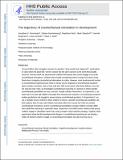| dc.contributor.author | Kominsky, JF | |
| dc.contributor.author | Gerstenberg, T | |
| dc.contributor.author | Pelz, M | |
| dc.contributor.author | Sheskin, M | |
| dc.contributor.author | Singmann, H | |
| dc.contributor.author | Schulz, L | |
| dc.contributor.author | Keil, FC | |
| dc.date.accessioned | 2022-02-01T15:23:05Z | |
| dc.date.available | 2022-02-01T15:23:05Z | |
| dc.date.issued | 2021-02-01 | |
| dc.identifier.uri | https://hdl.handle.net/1721.1/139823 | |
| dc.description.abstract | © 2021 American Psychological Association Young children often struggle to answer the question “what would have happened?” particularly in cases where the adult-like “correct” answer has the same outcome as the event that actually occurred. Previous work has assumed that children fail because they cannot engage in accurate counterfactual simulations. Children have trouble considering what to change and what to keep fixed when comparing counterfactual alternatives to reality. However, most developmental studies on counterfactual reasoning have relied on binary yes/no responses to counterfactual questions about complex narratives and so have only been able to document when these failures occur but not why and how. Here, we investigate counterfactual reasoning in a domain in which specific counterfactual possibilities are very concrete: simple collision interactions. In Experiment 1, we show that 5- to 10-year-old children (recruited from schools and museums in Connecticut) succeed in making predictions but struggle to answer binary counterfactual questions. In Experiment 2, we use a multiple-choice method to allow children to select a specific counterfactual possibility. We find evidence that 4- to 6-year-old children (recruited online from across the United States) do conduct counterfactual simulations, but the counterfactual possibilities younger children consider differ from adult-like reasoning in systematic ways. Experiment 3 provides further evidence that young children engage in simulation rather than using a simpler visual matching strategy. Together, these experiments show that the developmental changes in counterfactual reasoning are not simply a matter of whether children engage in counterfactual simulation but also how they do so. (PsycInfo Database Record (c) 2021 APA, all rights reserved) | en_US |
| dc.language.iso | en | |
| dc.publisher | American Psychological Association (APA) | en_US |
| dc.relation.isversionof | 10.1037/dev0001140 | en_US |
| dc.rights | Creative Commons Attribution-Noncommercial-Share Alike | en_US |
| dc.rights.uri | http://creativecommons.org/licenses/by-nc-sa/4.0/ | en_US |
| dc.source | PMC | en_US |
| dc.title | The trajectory of counterfactual simulation in development. | en_US |
| dc.type | Article | en_US |
| dc.identifier.citation | Kominsky, JF, Gerstenberg, T, Pelz, M, Sheskin, M, Singmann, H et al. 2021. "The trajectory of counterfactual simulation in development.." Developmental Psychology, 57 (2). | |
| dc.contributor.department | Massachusetts Institute of Technology. Department of Brain and Cognitive Sciences | |
| dc.contributor.department | Center for Brains, Minds, and Machines | |
| dc.relation.journal | Developmental Psychology | en_US |
| dc.eprint.version | Author's final manuscript | en_US |
| dc.type.uri | http://purl.org/eprint/type/JournalArticle | en_US |
| eprint.status | http://purl.org/eprint/status/PeerReviewed | en_US |
| dc.date.updated | 2022-02-01T15:18:42Z | |
| dspace.orderedauthors | Kominsky, JF; Gerstenberg, T; Pelz, M; Sheskin, M; Singmann, H; Schulz, L; Keil, FC | en_US |
| dspace.date.submission | 2022-02-01T15:18:44Z | |
| mit.journal.volume | 57 | en_US |
| mit.journal.issue | 2 | en_US |
| mit.license | OPEN_ACCESS_POLICY | |
| mit.metadata.status | Authority Work and Publication Information Needed | en_US |
